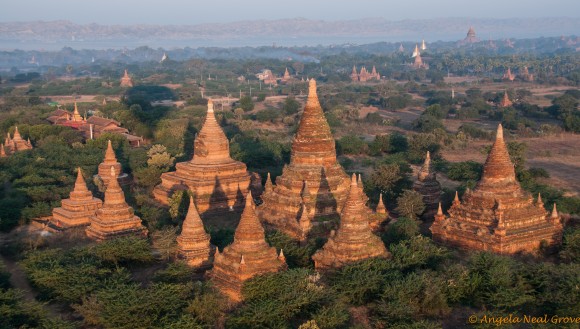
We lifted off the ground imperceptibly, quietly. The only sound was the huff and puff of the jet filling the balloon with hot air. The cluster of nationalities in the basket was silent, gazing at the scene below, mesmerized.
A few minutes before we had been standing in the grey pre-dawn light clutching warm cups of tea, a nod to the heritage of the balloon pilot who discussed essential pre-flight protocol. The sun was creeping over the horizon. Early morning mist and smoke from cooking fires wafted at ground level. It gave the scene an ethereal look, especially looking towards the broad expanse of the Irrawaddy River.
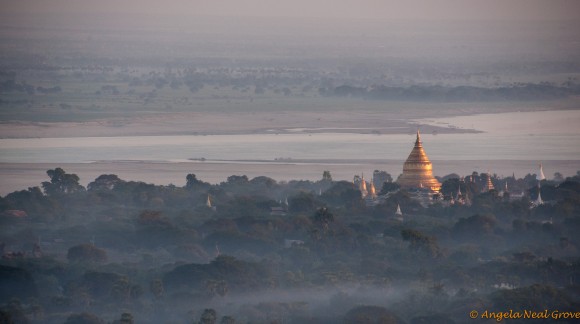
As we gained more height so did the sun washing the terra-cotta pagodas in warm light. We could also begin to see the expanse and broad sweep of the plain, dotted with hundreds of 12th century structures.
Bagan an Ancient Capital
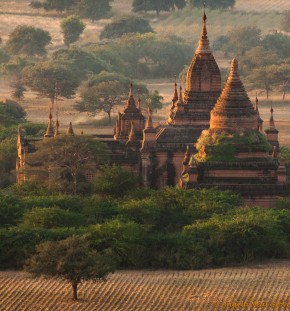
Bagan is an archaeological treasure trove dating from 1044. It was capital of the Bagan Empire which, in size, was roughly equivalent to modern day Myanmar. A prosperous cosmopolitan city, dominated by religion, whose rulers constructed over 13,000 religious monuments in a 40 square mile area.
It was known as the City of Four Million Pagodas and attracted monks from Ceylon, India and the adjacent Khmer Empire. Two hundred and fifty years later the empire collapsed because of repeated Mongol invasions. Today around 2,500 buildings remain.
Balloon pilot, Graham, interrupted our reverie and picture taking, pointing out two heavily laden oxcarts trundling below us. The monuments of Bagan are surrounded by fields and farming methods have changed very little through the centuries.
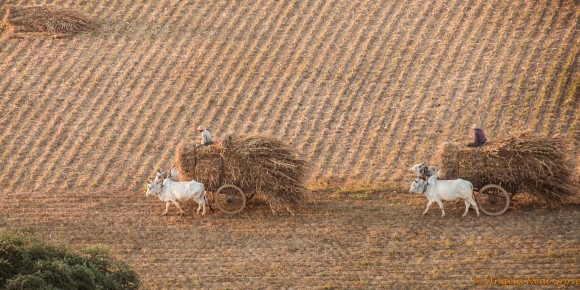
First visit in the 70’s
This was my second visit to Bagan. The first was before the 1975 devastating earthquake which destroyed many pagodas. Then, my restricted seven-day visa allowed a stay in the Russian built Inya Lake Hotel in Rangoon where the bathwater ran yellow and thin walls seemed bugged. Mandalay and Pagan, as it was then known, were the only other places I was cleared to visit. There accommodation was limited to government guest houses, modest but clean.
At that time there was a small asphalt airstrip long enough for the battered Fokker Friendship prop plane to land. It was just after the monsoons and the fields were bright green.
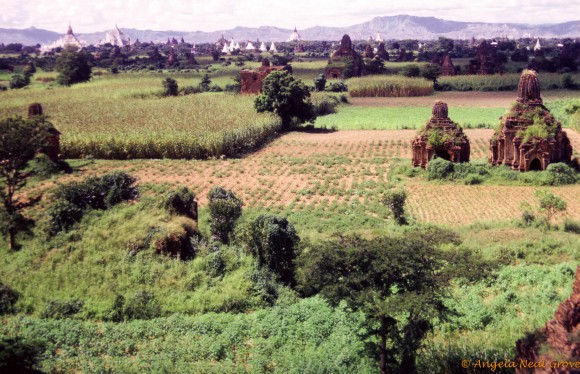
Many structures were crumbling. Some of the brick mounds were covered with tropical creeper or sprouting tufts of grass. Others were barely discernible. It was humid, and quiet except for cooing doves and chirping cicadas. There was an other worldly lost city feel. The stillness evocotive of spirts of the past.
Back to reality
Fast forward and back to the balloon. The sun was rising and from our birds eye view we could see activity on some pagodas below. A chance to photograph the sunrise or meditate. Even from the balloon we could see neat rows of shoes at the base of the pagoda steps.
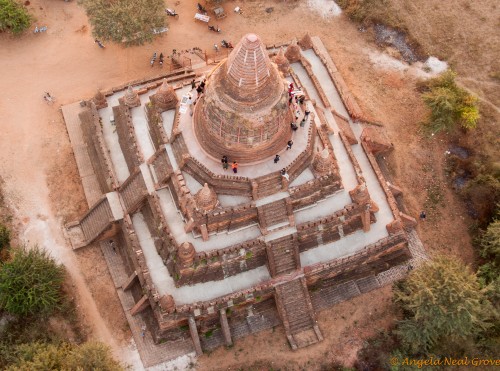
Looking down it was easy too to see how many of the monuments have been restored. There is discussion about the quality of some restoration. Much is said to have been done hurriedly to attract tourists. It does seem now that each monument has its tidy top-knot in place. So very different from my previous visit.
A site the size and importance of Bagan should be on UNESCO’s World Heritage List, but it is not. One explanation may be quality of restoration. As the country opens up perhaps funds will be available for more scholarly, well researched, restoration. In some places the work has begun.
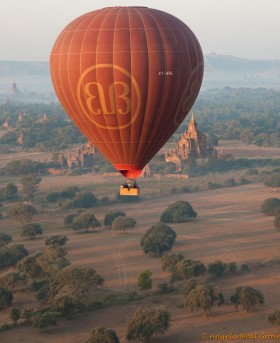
Onto the Sandbank
Now the wide ribbon of the mighty Irrawaddy River was in clear view. Historically, and still today, it is the main transportation artery in Myanmar, reaching from Yangon to its source near the Chinese border.
“I think we are headed for the sandbanks!” said Graham.
When the river is in full spate during and after the monsoons water spills over onto fields bringing huge quantities of silt. Villagers stake claims to sections of land as the water recedes, erecting temporary dwellings. They then grow crops in the fertile deposits, filling the banks with brilliant yellow sunflowers, beans and corn.
These sandbanks are also a good place for Balloons to land safely.
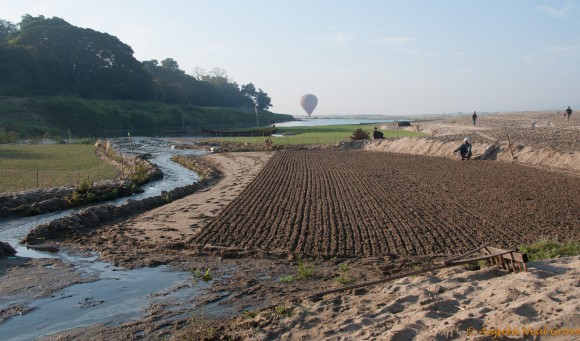
We clambered out of the basket and trudged up the sandy bank. We had listened carefully to, the Balloons over Pagan protocol before the flight, but it was safe compared with oxcarts barreling full bore down to the riverbank. We nimbly sidestepped them and then turned to watch the scene as women planted neat rows of spring onions in the rich alluvial soil. A scene which must have changed little for hundreds of years. Perhaps this was the scene when Bagan was at its most glorious?
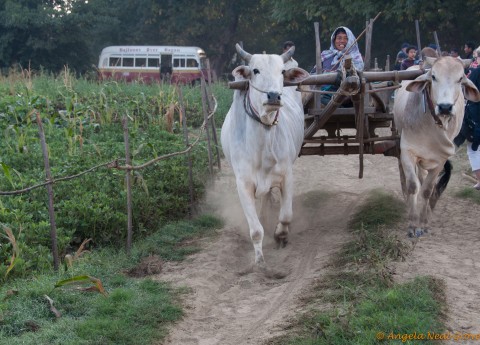
Time to move out of the way and not test the brakes.
Time now for breakfast. The balloon flight another prism in the kaliedescope of experiences on my return to Burma – or Myanmar as it now wishes to be known.
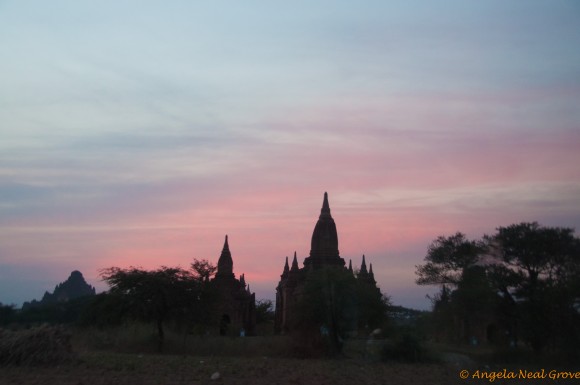
Amazing! Utterly Amazing! You tell it like it must have been but with such understanding, empathy, feeling, that it is as though I was there myself! Yes!
Thank you. It was a magical, memorable and once in a lifetime experience
Angela,
Once again you have taken me to a place I will never visit and have given me a true taste of what it is like along with your interesting and informative narrative.
Thank you! Beautiful!
Thank you so much Ina. Sharing my travels is such fun and makes it all doubly worthwhile. Burma/Myanmar is set to change so very rapidly.
Great items from you. You’re simply extremely great.
I really like what you’ve acquired here, certainly like what you are stating and the way through which you assert it.
You make it enjoyable and you continue to care for to keep it smart.
I can not wait to read much more from you. That is really a terrific site.